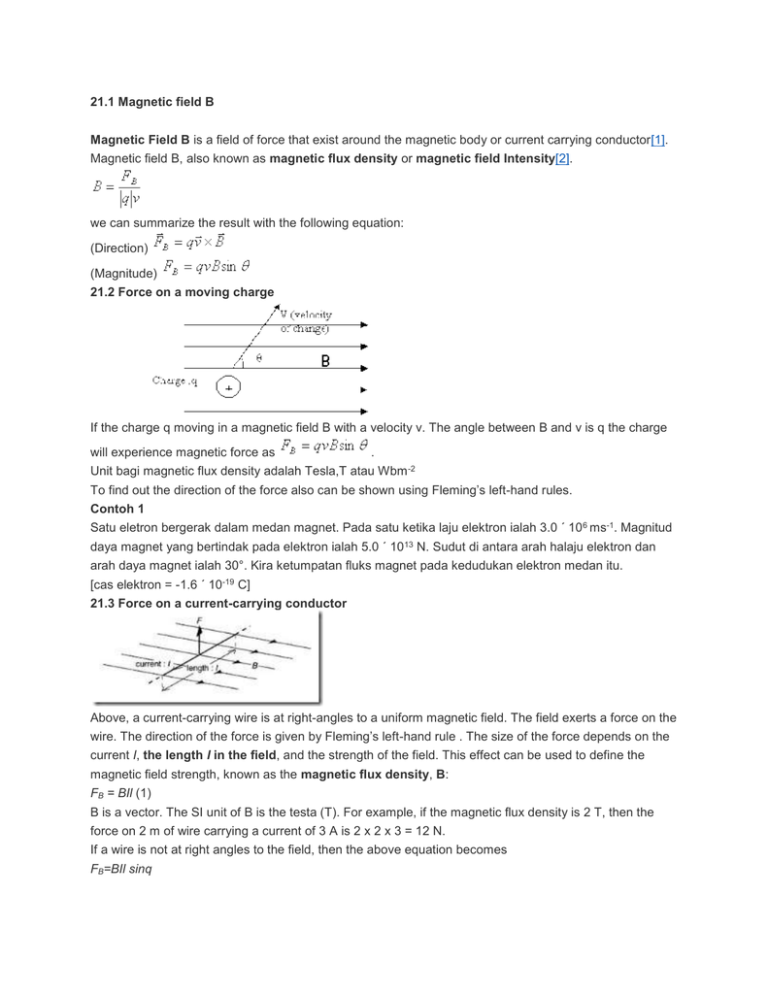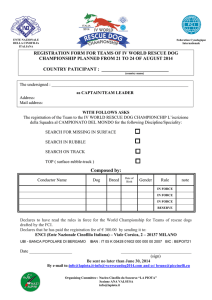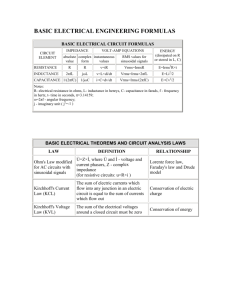21.1 Magnetic field B Magnetic Field B is a field of force that exist
advertisement

21.1 Magnetic field B Magnetic Field B is a field of force that exist around the magnetic body or current carrying conductor[1]. Magnetic field B, also known as magnetic flux density or magnetic field Intensity[2]. we can summarize the result with the following equation: (Direction) (Magnitude) 21.2 Force on a moving charge If the charge q moving in a magnetic field B with a velocity v. The angle between B and v is q the charge will experience magnetic force as . Unit bagi magnetic flux density adalah Tesla,T atau Wbm -2 To find out the direction of the force also can be shown using Fleming’s left-hand rules. Contoh 1 Satu eletron bergerak dalam medan magnet. Pada satu ketika laju elektron ialah 3.0 ´ 10 6 ms-1. Magnitud daya magnet yang bertindak pada elektron ialah 5.0 ´ 1013 N. Sudut di antara arah halaju elektron dan arah daya magnet ialah 30°. Kira ketumpatan fluks magnet pada kedudukan elektron medan itu. [cas elektron = -1.6 ´ 10-19 C] 21.3 Force on a current-carrying conductor Above, a current-carrying wire is at right-angles to a uniform magnetic field. The field exerts a force on the wire. The direction of the force is given by Fleming’s left-hand rule . The size of the force depends on the current I, the length l in the field, and the strength of the field. This effect can be used to define the magnetic field strength, known as the magnetic flux density, B: FB = BIl (1) B is a vector. The SI unit of B is the testa (T). For example, if the magnetic flux density is 2 T, then the force on 2 m of wire carrying a current of 3 A is 2 x 2 x 3 = 12 N. If a wire is not at right angles to the field, then the above equation becomes FB=BIl sinq where q is the angle between the field and the wire. As q becomes less, the force becomes less. When the wire is parallel to the field, sin q = 0, so the force is zero. Contoh 2 Satu konduktor lurus panjang 2m membawa arus 1.5A dan di letakkan dalam medan magnet. Medan itu mempunyai ketumpatan fluks magnet bermagnitud 3.0 ´ 10-3 T. Sudut antara arah medan dan konduktor ialah 30°. Kirakan magnitud daya magnet yang bertindak pada konduktor dan nyatakan arah daya itu. 21.4 Magnetic fields due to currents The Biot-Savart law, On the top, a short length dl of thin wire, carrying a current I, causes a magnetic flux density dB at P. According to the Biot-Savart law With a suitable constant, this can be turned into an equation: For a vacuum (and effectively for air), the value of k is 10-7 T m A-1. However, in practice, another constant, m0, is used, and the above equation is rewritten as follows: (2) m0 is called the permeability of free space. Its value is 4p x 10-7 T m A-1. This is not found by experiment. It is a defined value, linked with the definition of the ampere . Calculating magnetic flux density Using equation and calculus, it is possible to derive equations for B near wires and inside coils carrying a current I. B near an infinitely long, thin, straight wire At a distance a from such a wire (as on the top) Contoh 3 Arus sebanyak 10A mengalir melalui seutas dawai mencancang lurus yang panjang. Kirakan komponen mengufuk medan magnet Bumi. Jika terdapat satu titik neutral 8.0cm dari dawai itu. [m 0= 4p ´ 10-7 Hm-1] B at the centre of a thin coil Or the axis of such a coil, of N turns and radius r (as on the top), Contoh 4 Arus yang sama magnitud mengalir secara bergilir-gilir melalui seutas dawai tegak lurus yang panjang dan satu gegelung membulat berjejari 10cm dimana satahnya tegak dan selari dengan komponen mengufuk medan magnet pada titik berjarak 10cm di utara atau di selatan dari dawai itu terhadap paduan medan magnet di pusat gegelung itu. Contoh 5 Satu gegelung membulat diletakkan, dimana satahnya adalah mencancang dan paksinya membuat sudut kecil q dengan meridian magnet itu. Arus dilalukan mengelilingi gegelung supaya medan yang dihasilkan berkecenderungan untuk menentang medan Bumi. Satu magnet mengufuk yang kecil di letakkan di pusat gegelung itu. Perihalkan dan terangkan kesan ke atas magnet itu apabila kekuatan arus bertambah. Gegelung itu mempunyai jejari min 10cm,50 lilitan dan arus sebanyak 0.5A mengalir didalamnya. Jika q=12° dan magnet mengarah ke Timur-Barat.Kirakan komponen mengufuk medan magnet Bumi. B inside an infinitely long solenoid (coil) The field inside such a solenoid (as on above) is uniform. If n is the number of turn per unit length (per m), then B=µ0nI This equation is a reasonable approximation for any solenoid which is at least ten times longer than it is wide. Contoh 6 Berapa banyakkah lilitan mesti dipunyai oleh satu solenoid jika panjang solenoid itu 2.0m dan arus 5.0A mengalir melaluinya supaya arus menghasilkan ketumpatan fluks magnet bermagnitud 2.0 ´ 10-2 T di pusat solenoid ? B inside a solenoid with a core The value of B is changed by a core. For example, with a pure iron core, B is increased by a factor of about 1000 (depending on the temperature). The previous equation then becomes: B = µrµ0 nI µr, is called the relative permeability of the material. So, for pure iron, µr, is about 1000. An electromagnet is a solenoid with a core of high µr. 21.5 Force between two current-carrying conductors Force between two current-carrying wires X and Y above are two infinitely long, straight wires in a vacuum. The current in X produces a magnetic field, whose flux density is B at Y. As a result, there is a force on Y. F is the force acting on length l. From equation (3) From equation (1) FB = BI2 l Note: • The above equation gives the force of X on Y. Working out the force of Y on X gives exactly the same result. • If the two currents are in the same direction (as above), then the wires attract each other. If the two currents are in opposite directions, then the wires repel. Contoh 7 Tiga konduktor yang selari, P, Q dan R berada pada satah yang sama.Jarak antara P dan Q adalah 4cm dan antara Q dan R ialah 2 cm. Arus dalam P dan Q adalah 10A dan 5A masing-masing dan mengalir pada arah yang berlawanan.Daya paduan ke atas Q adalah 5 ´ 10-4N per meter dan bertindak ke arah P. Kirakan magnitud dan arah arus dalam R. 21.6 Definition of ampere Defining the ampere The SI unit of current is defined as follows: One ampere is the current which, flowing through two infinitely long, thin, straight wires placed one metre apart in a vacuum, produces a force of 2 x 10-7 newtons on each metre length of wire. Using the various factors in equation , the above definition can be expressed in the following form (for simplicity, units have been omitted): If I1=I2=1A,a=1m and l=1m,then F= 2×10-7N. Substituting these in equation above gives µ0 = 4p x 10-7. The above definition is not a practical way of fixing a standard ampere. This is done by measuring the force between two current-carrying coils. Current Balance - Measure current by using the principle of the force between two paralell wire using mechanical Prinsip: m = jisim pemberat W b = jarak F ke tuas c = jarak berat ke tuas L = jarak XY apabila sistem tuas seimbang kita dapati Known that FB = BIL B=µ0nI Maka FB = µ0n I . IL Then 21.7 Torque on a coil Lets consider the force on PQ and RS that involve in producing the torque. Force that produce on PQ and RS have the same magnitude but different direction. so force,F where L = height of coil(length of the coil in the magnetic field) and N = no. of turns carrying current,I. Torque where q = angle (below the horizontal from the plan view) between magnetic flux density and the coil. [coil area,A = Lb] So the equation for torque will be When q = 0° t = BIAN Contoh 8 21.8 Determination of ratio e/m and q/m Using an electron gun Lets consider the electron gun. Lets consider the movement of electron in an electro gun 1. The kinetic energy gain by electron = Electric potential energy of electron 2. Electron velocity : 3. Electric force, FE = Magnetic Force, FB , when it’s in equilibrium 4. From equation (2) and (3) we can conclude: Todetermine any positive charge,q/m using spectrometer. 1. any positivly charge velocity, 2. The charges follow the circular path, the centripetal force of the charge. 3.Magnetic force of charges Also for any specific charges. 21.9 Hall effect 1. apabila arus mantap I melalui konduktor/semikonduktor 2. kemudian diletakkan kedalam medan magnet yang kuat dimana I berserenjang dengan B. 3. Medan magnet melencongkan cas positif ke bahagian atas dan cas negatif ke bahagian bawah 4. Pemisahan ini menghasilkan medan elektrik E yang berserenjang dengan arah aliran arus I - Bila cas bertambah - Medan elektrik juga bertambah - Daya gerak elektrik juga meningkat 5. Pemisahan akan berhenti bila daya E, FE=FB Magnetic force = Electric force where [ Hall voltage n ialah halaju hanyut elektron,nbilangan elektron bebas]


